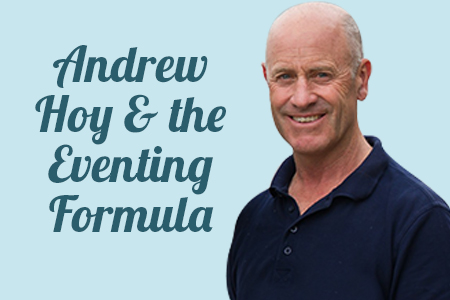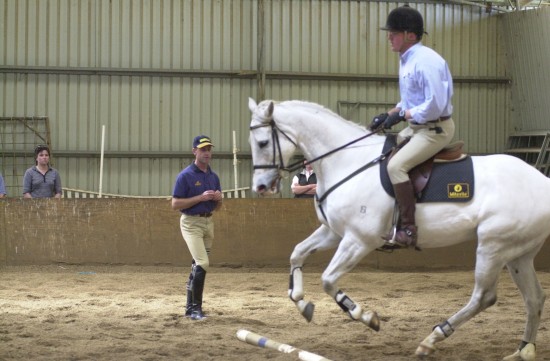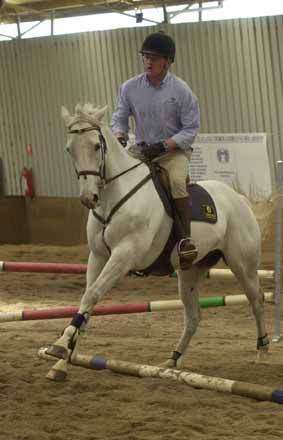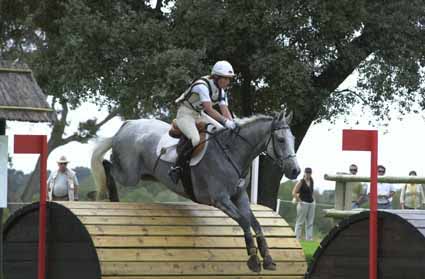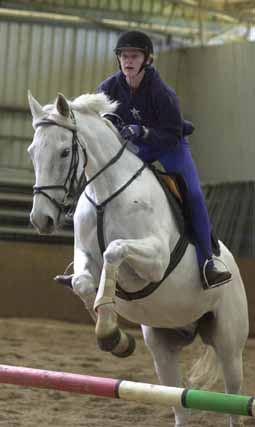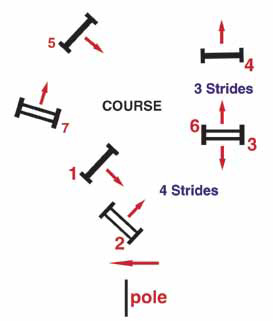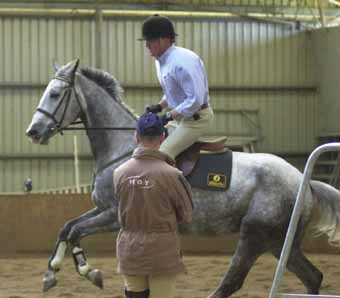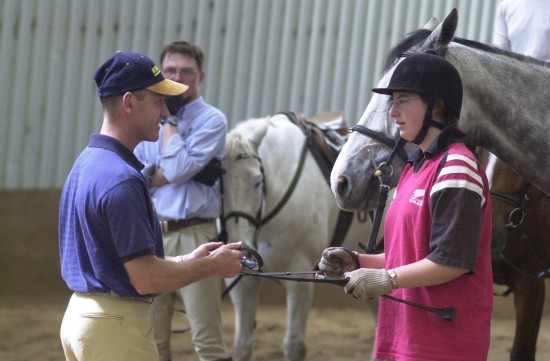Words and photos – Roz Neave
We all know Andrew Hoy, the ruthless competitor and gold medal winner. We cheered him on our home soil when he won not only a Gold Team Medal, but also Individual Silver, he was our hero. Fewer of us know Andrew the enthusiastic and sympathetic instructor. Whether he’s working with a talented junior, a galloping housewife trying to regain the talents of her youth, or a three-star rider honing his skills, the involvement and energy is there.
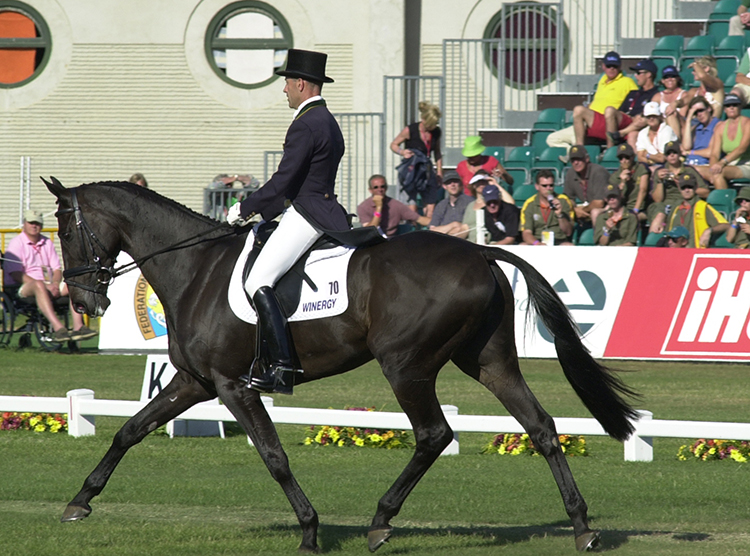
Andrew and Moonfleet at the WEG in Jerez
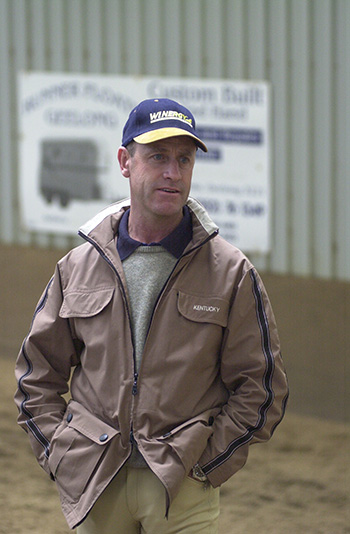
“What I want to give you, is the formula so that you can carry on when I’m not here as well. Today we are just going to be doing different lines, we are going to start off just trotting over the poles, cantering over the poles, so that you get the feeling, you get the rhythm and you get the understanding of how receptive the horse is, and the use of the leg and the hand – and correct position. It is normally not a matter of correcting the horse’s position, but correcting the rider’s position. So that the rider has the correct posture and the correct use of the aids, with this, the rider can then produce a quality approach to the horse. Getting to the fence and having a quality jump is all about having a quality approach. When you don’t have a quality approach, you don’t have a quality jump.”
“Let’s think about the balance of a horse. We know the horse cannot travel in good balance if the rider is out of balance. In some instances, by shortening a rider’s stirrups dramatically, it makes them ride in their own balance as opposed to having their legs wrapped around the horse, gripping and hanging on. To give you the extreme; if you ride dressage length over showjumps you can grip and hang on with your legs. If you move your stirrups to jockey length, then go to jump, you then have to ride in your own balance, because there is no way to keep your leg on the horse. Those are the extremes. I will force riders to ride in their own balance so they don’t rely on the saddle, or the horse to stay on.”
If you are riding a young green horse and it was not responding to the aids…
“You have to do something if you have no response to the aids. Exactly what you are doing, little circles, walk left, walk right, listen to me, listen to my leg, listen to my hand is exactly the way you should start. All of these things are produced. Like I was saying, horses are produced. They all come with similar talents – sure some of them are naturally more talented than others. Good riders keep producing the horses. It is not that they just have a good eye for a horse, it’s because they’ve got a good formula for producing the horses.”
So how does a rider develop a good horse?
“Whatever people are doing, no matter if they are doing dressage or showjumping or cross country, it all fits a formula, . I so often see riders warming up for dressage but they don’t have a formula, they don’t have a clear idea of how they need to go about it. Without a formula they don’t make the right preparation and then they can’t do their best when they go into the arena. They do walk, trot and canter and they go round and round in circles but really with no formula in mind. With any rider, if they are going to ride their horse, they have to ask, what is the formula for today? What are they trying to achieve with their horse?”
“They need to have an idea and a vision of what they are trying to achieve on that day. Is there anything that the horse is finding particularly difficult – say at the last competition – which needs working on? They need a formula, they need to work out in their own mind what they are aiming to achieve that day with that horse.”
“Then you have a competition formula. Then you have a yearly formula – where do you want to be at the end of this year, and at the end of next year… What are the goals? Some people the highest level they ever want to ride at is Novice. It doesn’t matter what level they are aiming for, as long as they find a way to achieve that level, and they break it down and find a formula and make it happen.”
“People want to ride at Novice level but they worry ‘how am I going to achieve that?’ Well, they set themselves that goal, they go and get some help, and they work on the dressage, then their showjumping and their cross-country skills. If you write down the things you need to do, often it is very achievable.”
Andrew constantly encouraged riders, and spectators to be involved in the session.
“Do you notice how much more balanced Vanessa and her horse are now that she’s riding with the shorter stirrups?”
“The one thing I am absolutely convinced of is that we never live long enough to learn enough from our own mistakes. We have to learn by other people’s mistakes. Invariably we end up making the mistake ourselves but if we see situation with someone else, you should think to yourself, this is something I need not do. You always have to turn those negatives into a positive. Too many people think in a negative manner. If you are walking up to a cross-country fence, then you can’t think – ‘oh I can’t do this’. That’s wrong. You have to think, ‘this is what I have to do’. You are saying the same thing, but you are saying it in a positive, as opposed to a negative way. It’s just a thought process in your mind – and here we come back to psychology. I think there is quite a lot of merit in sports psychology. There are many top athletes, but the ones that are consistent achievers are the ones with the positive thoughts. ‘I can achieve this, I can do it.’ People can always remember their bad faults, but the most important thing is to remember the good feelings. It’s the good feelings you need to reproduce.”
Despite Andrew’s positive approach, he was still smarting from his misfortune at Jerez…
“At Jerez, my fall from Moonfleet happened because I didn’t have a quality approach. I also allowed the horse to continue on, because I knew the horse had to start thinking for himself, but every horse makes a mistake at some stage, no matter how good they are – it was just a pity that mine happened at the most important event of the year.”
With the pole exercise – it’s so simple anyone could do it at home – what are the important things to think about with this exercise?
“When I go to jump a horse, be it Novice, Pre-novice or Advanced – I always start off working over a pole. The pole allows you to feel the rhythm of the horse, how to get to the pole so the pole comes in the middle of the canter stride. That’s one of the important issues, the pole must come in the middle of the canter stride. The canter stride must not be longer or shorter to go over the pole – it must stay in exactly the same rhythm. The pole also makes you stay in a good balance on the horse.”
“A lot of people when they get to the pole, they will lean forward or they’ll soften with the rein. For the horse to canter over the pole it is purely an elevated canter stride. And what is jumping? Jumping is purely an elevated canter stride. It is no longer, it is no shorter, it is exactly the same length of stride as the approach to the fence. A lot of riders get confused and think they have to make a big effort to jump the fence. No. All you can do is produce a good approach – and that is where the pole is very useful, because you can keep on coming and keep on reproducing the same canter to the pole.”
“Changing direction over the pole is a good way of getting the flying change established. It’s not that you have to teach the horse a flying change, it is just that you have to teach the horse the aids for the flying change. That’s where a lot of riders get a little confused, they say their horse won’t do a flying change. There horse will do a flying change but the problem is that they are not using the correct aids to get it when they want it.”
So off to work for the group.
“Let’s start off over the pole. Walk over pole once then trot over it, two times over in trot, and then into canter – don’t just sit there hoping it’s going to happen.”
After a couple of trot circles over the poles, it was time for a breather and discussion mode. Andrew had some observations of Vanessa and Nick’s young horses…
“There are difficulties with both of these young horses, and there’s a couple of reasons. One is that Vanessa hasn’t been riding as much as she would like to ride and the horses haven’t had the work. Secondly, the concepts of what Vanessa is working on are correct, but it’s just that it is not clear enough to the horse, it’s not consequent enough. Why it’s not, and why it’s clear with Nick and his horse, relates to the length of Nick’s body and the relative length of Vanessa’s body. Vanessa can be riding at 90 to 95% of her strength all the time, and that is only 80% of Nick’s strength. So when he has to use the other 10% or even 20%, and use 100% of his strength, he can carry it through with the horse a little more, then he can soften to them. But because Vanessa you are continually riding at 90-95% of your strength, and you become muscle fatigued, and therefore the use of the muscles is not clear enough, and the softening and taking, is over too narrow a range. That’s where Vanessa finds it very difficult. For a start it is a young horse, but also a strong horse and goes against you. Nick is taller and stronger.”
“I don’t think taller people realise the advantage of the length of body, the length of arms and legs they have. It is difficult for you particularly with these younger horses. It comes easier for someone like Bettina (Andrew’s wife) who is very clear in her concepts and her formula, because when she was three year old she had to ride around the arena in a dressage position, and she was always under instruction. She was never allowed to ride on her own or get on her pony and gallop over the field bareback, and that is why she is very disciplined in the area of schooling on the flat and that is why her dressage is so good (Bettina led the dressage field at Jerez with the best score ever at a major 3DE). It comes automatically for her. The advantage for Bettina is that when she goes into the dressage arena, she is not thinking, ‘What is the right formula?’ because for her it is so established, it is so ingrained into her train of thought and education.”
“The other side is that while I was galloping around the paddock at home on my pony and chasing kangaroos through the bush, I was learning the feel of going with the natural movement of the horse. Working in the arena all the time can become a little forced. But Bettina was working with the right people, and if you look at the top trainers, like Klaus Balkenhol, there is no way he forces any movement. When you see the top people from any discipline working and you have the opportunity to talk with them, they all talk about the rhythm, the balance, the understanding of what the horse is doing.”
Bettina and Woodsides Abbey at Jerez
“What comes automatically for me cross country didn’t come automatically for Bettina five or six years ago, but she has worked on the formula, and the concepts and it now comes very easy and very clear to her because she is very focussed on those areas.”
“Campdrafting is probably one of the things that taught me the most in that you are working with two animals, working with two minds.”
It’s just a pole on the ground, but Andrew was using the exercise to get the riders really focussed on their position, and balance.
“When you come around the turn, you need to be looking at the pole and thinking of the rhythm to it, and using your leg to get away from the wall, so that you actually keep the horse forward in a nice balance. Keep the horse nicely up in front of you and the hindquarters engaged. If you canter along with the hindquarters out behind, then it is not going to be so tidy when you jump a fence. You definitely need to be very conscious of your position on the horse.”
And still the rider must maintain position all the time…
“When you started walking over the pole Vanessa, you were too tight in the body, it was a forced position, you weren’t going with the rhythm of the horse.”
“I know this scenario. At the beginning of the year I went skiing, and because I hadn’t been skiing much, I was trying too hard, and I was also very nervous of the steepness of the slope and the speed. But I had to learn to accept these things to make the progression forward…. When we are cantering around over fences, the speed might be a little more than what you think is correct, but it is a matter of becoming comfortable with that rhythm and that speed.”
Next challenge for the group was a course of seven obstacles:
“Okay, I’ve got a little course set up here. Here are some of the things I would think about when I’m walking a schooling course. Coming from this first fence, my suggestion is that you come a little deeper in the turn and you come a fraction right to left so that you pick up right canter lead as you land. If you don’t get the right canter lead when you land, pick up the trot, and then canter on the right lead, unless you feel you can get the flying change.”
“You need to ride around the turn, a nice forward rhythm then when you get to this position you need to be looking up at the fence, and all the time keeping your eye on the fence, allowing your horse to canter in a good rhythm. A nice turn using your leg to keep the canter forward, then left to the next fence, it is a bending four strides, this is a nice distance for indoors as long as you put a good bend in it. If you come straight it is going to be too tight. So you need to stay wide on your turn and have a nice approach.”
“To the next fence, it is a quiet three strides not a forward three strides. When you jump this one, if you don’t have correct canter lead to the left, back to trot and pick it up again. By the time you have landed and come ten metres or so, you need to come back to trot and pick up the left lead before you start to turn.”
“Here looking at fence five, keep your eye on it, keeping your leg on, keeping the canter going forward. A lot of riders allow the horse to die in the turns, you’ve got to keep your leg on, to keep the canter, to keep the horse up in front of you, come on around, again, when you jump fence five you’ve got to be turning a fraction right handed. It doesn’t matter if you come a little wider, you need to create a nice turn to fence six. Another related distance with a slight right hand turn, then you need to come between the pole and fence two, and need to be looking at fence seven, the oxer. You can just ride this off a nice distance.”
Round one and Nick’s mare was having a few rails.
“If the mare is knocking down rails, you have to ask her to come from your leg, with a hand that is in front of you. Keep her up, then when you come to the fence, make sure you use your leg at the point of take-off. I see the situation where your leg may be becoming a little passive so that she then just jumps over the front end. What you need to do now is make sure she is always engaged from behind and that you use your leg, especially in the turns, to always kick her forward and up.”
“At this stage in her training you have to have her on a little bit nicer distances, otherwise you are educating her to just tap out the poles. She is not really responding to tapping the poles because she is leaning and pressing against your hands.”
“I know it feels very different but you’ve really got to keep her up in front of you and that’s quite hard at the moment – for where she is in her training. It is something you need to work on. When you ride her up in front, she produces a different quality of jump. At the moment if you ride her like a really good horse – riding her deep and softening to her – but it’s not going to happen. You have to help her a bit at the moment.”
“If she were to coming into my stables I’d probably work her through some combinations and grid type scenarios, but I’d set them up specifically for her, with distances she was comfortable with. Then I’d gradually shorten the distances, so you don’t teach her to run and bash the rails out.”
“In many situations riders try to force the horse to jump. All horses can jump to a certain degree. Bettina has a dressage horse that can jump a metre twenty! What I really want to work on with the younger horses is to let them enjoy it. But you also have to produce horses so that they are in their own balance and their own rhythm and then start working out of that. Not running them too deep so that they hit the fences is important – if you keep running them too deep and it is physically too difficult for them to leave the ground in a sharp manner, then their pain barrier becomes much higher. With horses you want them to have a low pain barrier, so that if they touch something, then they are more careful on the next fence. So what is important with young horses is that it is within their ability on that particular day.”
“You need a good rhythm, be it in the trot or the canter, then when you’ve got that rhythm established, you can work forward and back in that rhythm. But you don’t try to create a rhythm for a young horse that is steady and what you will ultimately create for your advanced horses. The art of riding young horses is to ride them within their comfort zone.”
After two rounds of the course, Andrew had these words for Vanessa and Nick
“You have jumped far more fences than these young horses. Your experience is far greater than the horses’ experience so therefore what you’ve got to try and do is work with their ability as it is today. That might not be what you want two years down the track, but you have to work with it today so you develop the trust, and the horse develops an understanding of what is needed.”
“Ultimately you can collect the canter much more, once you’ve done two or three years developing the work on the flat, but it is working out of the rhythm that the horse is most comfortable with at the time that is important, and that rhythm and strength will alter. If you don’t work with their natural pace to start with, then you can’t develop that pace.”
“A horse’s natural pace varies. Some horses have really good natural paces, and others don’t have the quality of natural paces. A classic example of this is the horse that I rode at Burghley this year. When he first came to me at the beginning of last year, his rhythm and his natural paces were not very good but then at Burghley I was second after the dressage. Pippa Funnell and Mary King said they couldn’t believe how differently the horse was going. . Why? Because you work with the rhythm the horse has. The trot was really fast but I let that get established and then started to work forward out of that rhythm, forward and back. Then you can create horses that can move. That’s what Bettina is very good at doing, finding the natural rhythm of the pace. That is something you need to develop if you want on to become successful.”
The next pupil, Jessica does not have Vanessa and Nick’s problem. Her stately grey mount is as experienced as theirs are green. It was a most attractive picture, but Andrew found some areas for Jessica to work on…
“Jessica, you restrict your horse’s canter rhythm too much with the hand. Do you understand what I am talking about? Understanding is one thing, doing it is another. If you understand what I am talking about, then you can get a picture of it in your mind, but it might be two, three, four days down the track riding at home, when you say THAT’S what he was talking about.”
“You’ve got to have better use of your leg, and this is something I would see as a common fault amongst the majority of the riders. You don’t have the right balance in the use of the hand in relation to the use of the leg. The horse runs on, so the rider ends up holding against the horse, it’s a little bit what happens to you. It has to always come from behind, it has to be the use of the leg first forward to the hand which says, whoa no faster, and then allows forward. Lots of riders don’t allow forward through the elbows. It’s got to come through an allowing of the elbows, not a softening of the fingers.”
“Let’s do it again. Think of using your leg before you use your hand.”
“Jump the first three or four fences again, counting the rhythm. You must ride with the rhythm of the horse. You leant forward going to the fence, leaning forward is dangerous, you end up in a knee brace if you lean forward!”
“If you actually count the canter rhythm, that makes you wait. It makes you wait because you are counting the rhythm of the horse and you end up going with the rhythm. It is also very important that you look at the fence, that also makes you wait. Going in front of the movement of the horse is a recipe for disaster. Do the whole thing again, and this time, count the rhythm. Count it aloud so it is very clear – counting aloud is often better than counting to yourself especially in the initial stages. Don’t just sit there and wait for the happy ride because it will very soon become an unhappy one.”
With those final words, it ended the session for the day. No doubt however there will be plenty discussion tonight over the Marcus Oldham dinner table.



